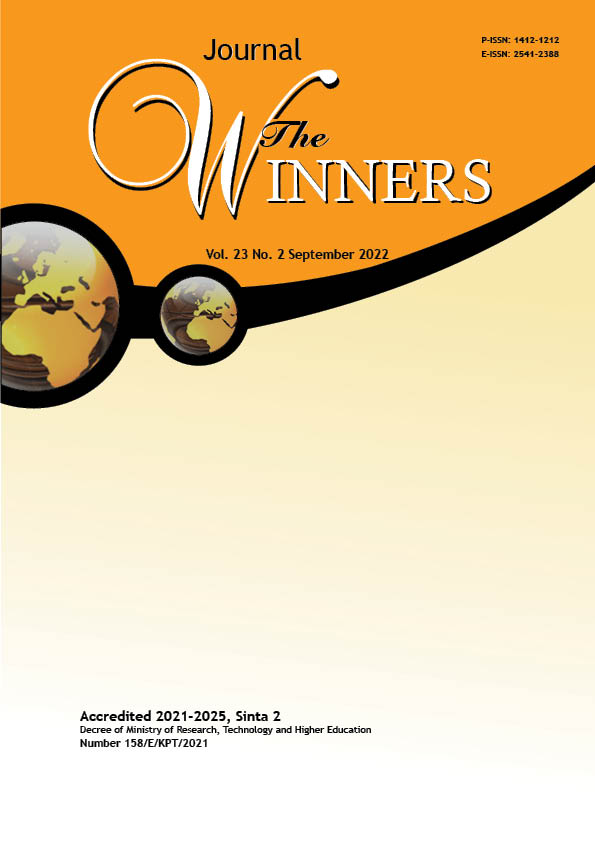Domestic Credit and Stock Market Impact on Economic Growth: A New Evidence in Five ASEAN Countries
DOI:
https://doi.org/10.21512/tw.v23i2.7066Keywords:
domestic credit, stock market, economic growth, financial development, ASEANAbstract
Capital accumulation and technological innovation had been the two channels through which the financial sector plays a vital role in the growth of economy. However, there are some different results between banking and stock market. The research tested the Solow-Swan growth model augmented with financial markets to show that domestic credit markets and equity from stock markets are two long run determinants of Gross Domestic Products (GDP) per capita in five ASEANÂ
countries: Indonesia, Malaysia, Singapore, Thailand, and Philippines. The research used data from 2000 to 2019 tested with panel regression. The result shows that all determinant variables have a positive impact on economic growth. The domestic credit also has a higher impact on the growth of economy than the stock market. In addition, domestic credit and stock market has statistically significant positif impact to economic growth across five ASEAN countries. The research
also finds that although population in five ASEAN countries give positive effect to economic growth, it is statistically not convincing. It is suggested that people in ASEAN have already used technology, so population augmented encourages economic growth.Â
References
Aali-Bujari, A., Venegas-MartÃnez, F., & Pérez-Lechuga, G. (2017). Impact of the stock market capitalization and banking spread in growth and development in Latin America: A panel data estimation with System GMM. Contaduria y Administracion, 62(5), 1427–1441. https://doi.org/10.1016/j.cya.2017.09.005
Bank Indonesia. (2017, October 20). Tinjauan kebijakan moneter Oktober 2017. Investing.com. https://id.investing.com/central-banks/bank-indonesia/speeches/tinjauan-kebijakan-moneter-oktober-2017-200197557
Bank Indonesia. (2018, April 20). Tinjauan kebijakan moneter bulan April 2018. Invesing.com. https://id.investing.com/central-banks/bank-indonesia/speeches/tinjauan-kebijakan-moneter-bulan-april-2018-200201112
Barradas, R. (2020). Does the financial system support economic growth in times of financialisation? Evidence for Portugal. International Review of Applied Economics, 34(6), 785-806. https://doi.org/10.1080/02692171.2020.1782854
Bencivenga, V. R. & Smith, B. D. (1991). Financial intermediation and endogenous growth. The Review of Economic Studies, 58(2), 195. https://doi.org/10.2307/2297964
Camba, A. C. & Camba, A. L. (2020). The dynamic relationship of domestic credit and stock market liquidity on the economic growth of the Philippines. Journal of Asian Finance, Economics and Business, 7(1), 37–46. https://doi.org/10.13106/jafeb.2020.vol7.no1.37
Chen, H., Hongo, D. O., Ssali, M. W., Nyaranga, M. S., & Nderitu, C. W. (2020). The asymmetric influence of financial development on economic growth in Kenya: Evidence from NARDL. SAGE Open. https://doi.org/10.1177/2158244019894071
Chu, L. K. (2019). The effects of financial development on economic sophistication: Evidence from panel data. Applied Economics Letters, 27(15), 1260–1263. https://doi.org/10.1080/13504851.2019.1676866
Divisi Penelitian dan Asesmen Internasional, Departemen Internsional. (2018). Perkembangan Ekonomi Keuangan dan Kerja Sama Internasional (PEKKI) Edisi IV 2018. Bank Indonesia.
Divisi Penelitian dan Asesmen Internasional, Departemen Internsional. (2019). Perkembangan Ekonomi Keuangan dan Kerja Sama Internasional (PEKKI) Edisi IV 2019. Bank Indonesia.
Durusu-Ciftci, D., Ispir, M. S., & Yetkiner, H. (2017). Financial development and economic growth: Some theory and more evidence. Journal of Policy Modeling, 39(2), 290–306. https://doi.org/10.1016/j.jpolmod.2016.08.001
Fufa, T. & Kim, J. (2018). Stock markets, banks, and economic growth: Evidence from more homogeneous panels. Research in International Business and Finance, 44, 504–517. https://doi.org/10.1016/j.ribaf.2017.07.120
Greenwood, J. & Smith, B. D. (1997). Financial markets in development, and the development of financial markets. Journal of Economic Dynamics and Control, 21(1), 145–181. https://doi.org/10.1016/0165-1889(95)00928-0
Guru, B. K. & Yadav, I. S. (2019). Financial development and economic growth: panel evidence from BRICS. Journal of Economics, Finance and Administrative Science, 24(47), 113–126. https://doi.org/10.1108/JEFAS-12-2017-0125
Haini, H. (2020). Examining the relationship between finance, institutions and economic growth: evidence from the ASEAN economies. Economic Change and Restructuring, 53(4), 519–542. https://doi.org/10.1007/s10644-019-09257-5
Hill, R. C., Griffiths, W. E., & Lim, G. C. (2011). Principles of Econometrics (4th Ed.). Hoboken: John Wiley & Sons, Inc.
Ho, C. H. P., Pham, N. N. T., & Nguyen, K. T. (2021). Economic growth, financial development, and trade openness of leading countries in ASEAN. Journal of Asian Finance, Economics and Business, 8(3), 191–199. https://doi.org/10.13106/jafeb.2021.vol8.no3.0191
Ibrahim, M. & Alagidede, P. (2018). Nonlinearities in financial development–economic growth nexus: Evidence from sub-Saharan Africa. Research in International Business and Finance, 46, 95–104. https://doi.org/10.1016/j.ribaf.2017.11.001
Kumar, K. & Paramanik, R. N. (2020). Nexus between Indian economic growth and financial development: A non-linear ARDL approach. The Journal of Asian Finance, Economics and Business, 7(6), 109–116. https://doi.org/10.13106/jafeb.2020.vol7.no6.109
Levine, R. (1996). Stock markets: A spur to economic growth. Finance and Development, 33(1), 7–10. https://doi.org/10.5089/9781451953190.022
Levine, R. (1997). Financial development and economic growth: Views and agenda. American Economic Association, 35(2), 688–726. https://doi.org/http://www.jstor.org/stable/2729790
Malarvizhi, C. A. N., Zeynali, Y., Al Mamun, A., & Bin Ahmad, G. (2019). Financial development and economic growth in ASEAN-5 countries. Global Business Review, 20(1), 57–71. https://doi.org/10.1177/0972150918802684
Mankiw, N. G., Romer, D., & Weil, D. N. (1992). A contribution to the empirics of economic growth. Quarterly Journal of Economics, 107(2), 407–437. https://doi.org/10.2307/2118477
Nasir, M. A., Duc Huynh, T. L., & Xuan Tram, H. T. (2019). Role of financial development, economic growth & foreign direct investment in driving climate change: A case of emerging ASEAN. Journal of Environmental Management, 242, 131–141. https://doi.org/10.1016/j.jenvman.2019.03.112
Sharma, R. & Kautish, P. (2020). Linkages between financial development and economic growth in the middle-income countries of South Asia: A panel data investigation. Vision, 24(2), 140–150. https://doi.org/10.1177/0972262920923908
Tariq, R., Khan, M. A., & Rahman, A. (2020). How does financial development impact economic growth in Pakistan?: New evidence from threshold model. The Journal of Asian Finance, Economics and Business, 7(8), 161-173. https://doi.org/10.13106/jafeb.2020.vol7.no8.161
The World Bank. (2019). DataBank: World Development Indicators. https://databank.worldbank.org/source/world-development-indicators
Wu, C., Huang, S., & Chang, T. (2020). The nexus of financial development and economic growth across major Asian economies: Evidence from bootstrap ARDL testing and machine learning approach. Journal of Computational and Applied Mathematics, 372. https://doi.org/10.1016/j.cam.2019.112660
Downloads
Published
How to Cite
Issue
Section
License
Copyright (c) 2022 Tuti Eka Asmarani, Endah Ayu Ningsih

This work is licensed under a Creative Commons Attribution-ShareAlike 4.0 International License.
Authors who publish with this journal agree to the following terms:
a. Authors retain copyright and grant the journal right of first publication with the work simultaneously licensed under a Creative Commons Attribution License - Share Alike that allows others to share the work with an acknowledgment of the work's authorship and initial publication in this journal.
b. Authors are able to enter into separate, additional contractual arrangements for the non-exclusive distribution of the journal's published version of the work (e.g., post it to an institutional repository or publish it in a book), with an acknowledgment of its initial publication in this journal.
c. Authors are permitted and encouraged to post their work online (e.g., in institutional repositories or on their website) prior to and during the submission process, as it can lead to productive exchanges, as well as earlier and greater citation of published work.
USER RIGHTS
All articles published Open Access will be immediately and permanently free for everyone to read and download. We are continuously working with our author communities to select the best choice of license options, currently being defined for this journal as follows: Creative Commons Attribution-Share Alike (CC BY-SA)

















